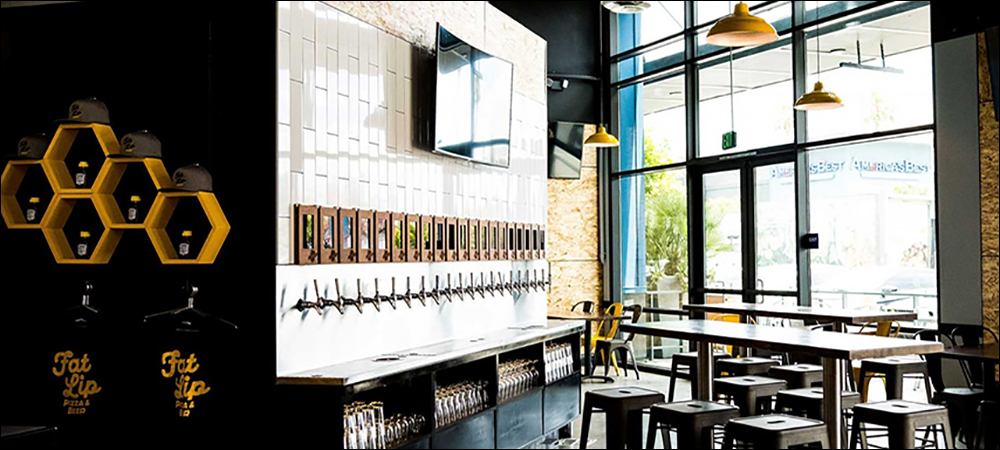- Fat Lip Pizza Features iPourIt RFID Self-Serve Tap
- Touch ‘n Go, Shell Malaysia Enable RFID Gas Pump Payments
- ClearBlade Unveils IoT Software-as-a-Service Platform
- Cantaloupe, MSU Study Shows Contactless Payments Soaring
- Lord Hobo Brewing Co. Deploys Preddio Digital Twin Tech
- IIC Extends IoT Security Maturity Model
Presented here are recent news announcements in the radio frequency identification and Internet of Things industries.
Fat Lip Pizza Features iPourIt RFID Self-Serve Tap
Fat Lip Pizza, an East Coast-style slice shop that originated as a food truck, has opened its first brick-and-mortar restaurant in Corona, Calif. The new shop features a 20-tap self-pour draft system powered by iPourIt‘s RFID technology. The tap wall offers a rotating selection of draft beverages, mostly from local breweries and wineries, and customers can explore details on touchscreens located above the taps. RFID wristbands activate the system and track the number of ounces poured.
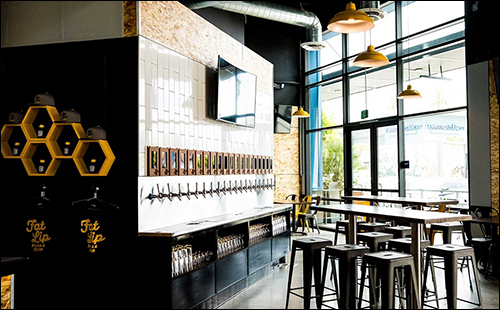 Owners Chris and Veronica Laramie started the food truck after 25 years in the restaurant industry, then expanded to a full restaurant offering a combination of New York-style thin crust and Neopolitan-style pies. “Every food truck has the goal to become a brick-and-mortar, but we hadn’t considered the beer aspect until we found the location,” said Chris Laramie in a prepared statement. “We upgraded the self-pour tech to the latest platform, and now we’re not only pulling in customers with the pizza, but also the beer selection.”
Owners Chris and Veronica Laramie started the food truck after 25 years in the restaurant industry, then expanded to a full restaurant offering a combination of New York-style thin crust and Neopolitan-style pies. “Every food truck has the goal to become a brick-and-mortar, but we hadn’t considered the beer aspect until we found the location,” said Chris Laramie in a prepared statement. “We upgraded the self-pour tech to the latest platform, and now we’re not only pulling in customers with the pizza, but also the beer selection.”
The RFID-based self-pour tap wall eliminates the need for businesses to build out a traditional bar, allowing additional space for seating. This avoids the effort involved in having to staff a trained bartender for alcohol service, the company explains, and cashiers can learn the system and provide guests with tutorials. iPourIt offers integration with the Untappd beer platform and updates the menu automatically, allowing app users to view what is available on tap at any given time.
“We guide customers through the process the first time, and after that it’s a no-brainer,” Laramie added in the statement. “It’s a ‘choose your own adventure’ experience. They can pour as much or as little as they want and sample through the things they haven’t seen before. They’re loving it—lots of people have never seen it before and think it’s like space-age craziness.”
Touch ‘n Go, Shell Malaysia Enable RFID Gas Pump Payments
Touch ‘n Go Group and Shell Malaysia have launched a cashless payment system that enables customers to pay for fuel using the company’s Touch ‘n Go RFID solution at 88 Shell stations throughout that country. The number of stations equipped with the cashless-fueling solution is expected to double by the end of the year, the companies report.
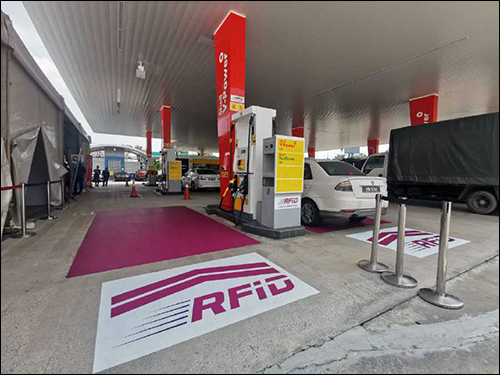 “We’re extremely pleased to have so quickly been able to expand the RFID use case beyond road tolling,” said Effendy Shahul Hamid, Touch ‘n Go Group’s group chief executive officer, in a prepared statement. “Customers can now make payments at Shell stations without requiring any interaction with an app on their mobile phones or engaging with a point-of-sale system, as payment is made via Touch ‘n Go eWallet linked to the users’ Touch ‘n Go RFID.” The combination of an RFID and eWallet infrastructure allows use cases beyond tolling, he explained, “and we will be expanding the RFID use case into more areas as we go on.”
“We’re extremely pleased to have so quickly been able to expand the RFID use case beyond road tolling,” said Effendy Shahul Hamid, Touch ‘n Go Group’s group chief executive officer, in a prepared statement. “Customers can now make payments at Shell stations without requiring any interaction with an app on their mobile phones or engaging with a point-of-sale system, as payment is made via Touch ‘n Go eWallet linked to the users’ Touch ‘n Go RFID.” The combination of an RFID and eWallet infrastructure allows use cases beyond tolling, he explained, “and we will be expanding the RFID use case into more areas as we go on.”
To use Touch ‘n Go RFID at Shell petrol stations, customers need an RFID tag linked to their Touch ‘n Go eWallet account, requiring a one-time registration and activation. Upon successful activation, they can park their vehicle at one of Shell’s RFID-designated fueling bays. The vehicle is detected within seconds, and payment is automatically debited from eWallet, allowing them to proceed with refueling their car. Any unutilized amount is then refunded to their eWallet account.
Until Sept. 16, 2022, Shell and Touch ‘n Go will reward the first 25,000 customers who purchase fuel at Shell stations using the Touch ‘n Go RFID system. Customers would need to pump a minimum of 50 Malaysian ringgiton ($11.15) worth of fuel during their first Touch ‘n Go RFID transaction at Shell to receive a 10 ringgiton ($2.23) cashback. Those eligible for this cashback would be first-time users of the feature.
“In line with our commitment in making our customers’ daily journeys more seamless through innovative offerings, we embarked on this partnership with Touch ‘n Go to develop a new payment method that provides cashless convenience, using RFID technology, without the hassle of a mobile app,” said Seow Lee Ming, Shell Malaysia’s general manager of mobility, in a prepared statement. “We also went the extra mile to integrate Touch ‘n Go RFID with our loyalty partner BonusLink, allowing customers to earn loyalty points easily with each fuel purchase.”
ClearBlade Unveils IoT Software-as-a-Service Platform
Internet of Things (IoT) platform provider ClearBlade has announced a software-as-a-service product known as ClearBlade IoT Core, which offers cloud service capabilities, scaling and security for enterprise customers. For existing Google Cloud IoT Core customers, ClearBlade provides a one-click migration process. The fully managed service is designed to securely connect, manage and ingest data from globally distributed devices, the company reports.
IoT Core features device registry and management, messaging via a scalable MQTT broker, mapping of topics to GCP PubSub and enterprise integrations via REST APIs, and the system can be upgraded to a private instance of ClearBlade’s IoT Enterprise product. The IoT platform provides a code engine that performs inline stream processing, integrates directly with enterprise software, offers built-in data-as-a-service, and features ONNX-based artificial intelligence (AI) for predictive maintenance. ClearBlade provides its no-code Intelligent Assets application to monitor and control assets.
With the announcement of Google Cloud’s IoT Core deprecation, ClearBlade intends to serve existing customers as a Google-approved independent software vendor and migration service integrator. According to ClearBlade, Google has reviewed and authorized its IoT Core as a replacement offering. ClearBlade provides a one-click process for a full migration of all server-side assets, including device records, authentication certificates and PubSub topic mappings.
“IoT solution developers already have their plates full with building new features to spend time building a new solution to replace what is already working,” said Aaron Allsbrook, ClearBlade’s CTO, in a prepared statement. “ClearBlade IoT Core provides the exact capabilities in-house today, with the smallest possible impact to existing working systems.” End users will experience no changes in device authentication, the company notes, and pricing will remain unchanged.
Cantaloupe, MSU Study Shows Contactless Payments Soaring
Cantaloupe, a digital payments and software services company that provides technology-based solutions for unattended retail, has partnered with Michigan State University (MSU)’s Broad College of Business for a joint study on payment trends in that market. The study has analyzed a sample set of 160,000 Cantaloupe ePort cashless devices across various location segments, and it shows that contactless transactions at vending machines soared from January 2020 to October 2021 during the height of the COVID-19 pandemic.
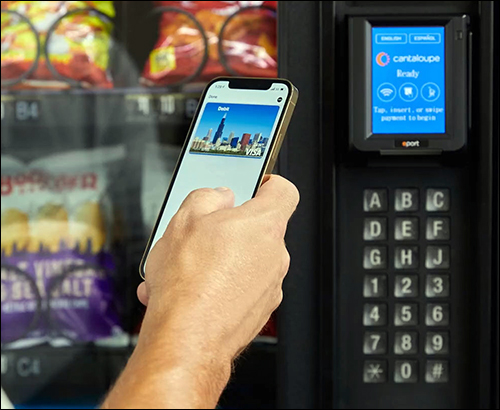 Titled “Payments in Unattended Retail,” the report reveals that the overall share of cashless transactions increased from 51 percent in January 2020 to 62 percent in October 2021, compared to cash transactions, which decreased from 49 percent to 38 percent. The rise in cashless payments overall is driven by consumer adoption of contactless payments, the study notes, or other payment methods using RFID or Near Field Communication (NFC) technologies to “tap to pay,” such as credit or debit cards with a chip, or a mobile wallet.
Titled “Payments in Unattended Retail,” the report reveals that the overall share of cashless transactions increased from 51 percent in January 2020 to 62 percent in October 2021, compared to cash transactions, which decreased from 49 percent to 38 percent. The rise in cashless payments overall is driven by consumer adoption of contactless payments, the study notes, or other payment methods using RFID or Near Field Communication (NFC) technologies to “tap to pay,” such as credit or debit cards with a chip, or a mobile wallet.
Cantaloupe’s study found that during this period, contactless transactions grew steadily month to month, from 18 percent of total transactions to 43 percent of total cashless transactions. The research reflects observed consumer payment trends toward cashless payments when customers pay in person, driven by an increased adoption of contactless payment methods. Based on the data, the study predicts contactless payments will grow another 31 percent throughout this year.
“When we analyze our entire network of devices throughout the first half of 2022, we’re seeing contactless payment methods make up nearly half of all cashless transactions,” said Sean Feeney, Cantaloupe’s CEO, in a prepared statement. “And these trends aren’t slowing down. The data indicates that by the end of 2022, more than two-thirds of all transactions will be cashless, driven by consumers preferring to tap. For vending operators, this underlines the importance of offering contactless payment options if they want to increase revenue and remain competitive.”
Cantaloupe’s purchase data from January to November 2021 shows an increase of Europay, Mastercard and Visa (EMV) digital payments, from one million to three million transactions. Cantaloupe predicts the number of EMV transactions will grow by an additional two million in 2022, reflecting the impact of EMV security changes by payment processors and card brand issuers. According to the company, vending operators face revenue risks if their card readers are not EMV-compliant.
Lord Hobo Brewing Co. Deploys Preddio Digital Twin Tech
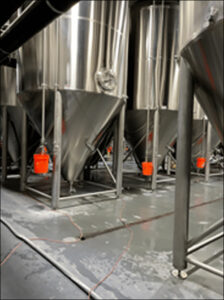 Preddio Technologies, a provider of digital twin solutions for condition-based maintenance and productivity gains, has announced that Lord Hobo Brewing Co. has deployed its Preddio Simplicity solution. Lord Hobo is using Preddio’s sensors to monitor the correct amount of chemicals consumed during cleaning cycles in real time, and to determine how long to rinse its brewery assets for the purposes of water savings.
Preddio Technologies, a provider of digital twin solutions for condition-based maintenance and productivity gains, has announced that Lord Hobo Brewing Co. has deployed its Preddio Simplicity solution. Lord Hobo is using Preddio’s sensors to monitor the correct amount of chemicals consumed during cleaning cycles in real time, and to determine how long to rinse its brewery assets for the purposes of water savings.
“Continuous improvement is essential for our brewery,” said Keith Gabbett, Lord Hobo’s brewmaster, in a prepared statement. “In working with Preddio Technologies, we now have access to data on our CIP [clean-in-place] processes, our fermentations, and broader brewhouse operations and utilities. The ability to track these processes in real time allows us to improve our efficiencies and even reduce chemical and water usage. The automated alerts that we have set for our major utilities gives us peace of mind, even when we’re not there.”
Preddio’s technology is designed for use by food and beverage manufacturers such as Lord Hobo, using industrial- and commercial-grade equipment for sanitary production applications. CIP, as well as good manufacturing processes and traceability, are critical for such companies, Preddio explains, and closely monitoring production equipment and essential process parameters via digital twin and condition-monitoring technologies can enable them to comply with regulations.
“Most CIP cycles are purely based on time, regardless of actual chemical concentration, and are not traceable from a quality-control perspective,” added Aaron Ganick, Preddio’s CEO, in the statement. “Our digital twin solutions allow users to accurately monitor in real time the conductivity and temperature of their CIP cycles, to monitor chemical concentration and clean water consumption efficiently. This allows breweries to not only reduce the amount of chemicals used and time spent cleaning tanks, but also creates massive cost-saving opportunities due to the significant reduction of clean water consumption and wastewater processing fees.”
IIC Extends IoT Security Maturity Model
The Industry IoT Consortium (IIC) and the International Society of Automation have announced the release of the “IoT Security Maturity Model: 62443 Mappings for Asset Owners, and Product Suppliers, and Service Suppliers” (IIC IoT SMM). As coauthor Ron Zahavi, Microsoft‘s chief strategist for IoT standards, explained in a prepared statement, “This new guidance adds the service provider role. It extends the previously published ‘IoT Security Maturity Model (SMM): Practitioner’s Guide’ to provide mappings to existing 62443 standards, and specific guidance for the asset owner, product supplier and service provider roles.”
The IIC IoT SMM, the organization explains, is intended to help organizations choose their security target state and determine their current security state. By repeatedly comparing the target and current states, businesses can identify where they can make further improvements. The ISA99 committee developed the 62443 series of standards, which the International Electrotechnical Commission adopted. The standards address current and future vulnerabilities in Industrial Automation and Control Systems, and they apply necessary mitigation systematically and defensibly. The ISA/IEC 62443 standards focus on maturity, but only on the maturity of security programs and processes.
“Achieving security maturity targets can be difficult to put into practice without concrete guidance,” added Frederick Hirsch, a cochair of the IIC ISA/IIC Contributing Group, in the statement. “These 62443 mappings enable practitioners to better achieve security maturity by relating IIC IoT SMM practice comprehensiveness levels to ISA/IEC 62443 requirements. In this way, IACS asset owners and product suppliers can achieve appropriate maturity targets more easily.”
Eric Cosman, an ISA99 cochair, noted, “While standards such as ISA/IEC 62443 are needed to codify proven and accepted engineering practices, they are seldom sufficient. Joint efforts such as this provide the practical guidance necessary to promote and support their adoption.” And Pierre Kobes, a member of both ISA99 and IEC Technical Committee 65, added, “It is not about more security but about implementing the appropriate security measures. IoT SMM: 62443 Mappings for Asset Owners and Product Suppliers helps companies select the adequate security levels commensurate with their expected level of risk.”

